Oregon militia elicits rural supporters – including unwanted ones
Loading...
As Ammon Bundy and his militia enter the second week of their government standoff in Burns, Oregon, conservative supporters from around the country are eager to join – including unwanted ones.
At the Malheur national wildlife refuge Saturday, a large group of armed men pulled into the compound in more than a dozen cars. The origingal occupiers had just finished a press conference, and their new visitors lined themselves along a nearby road.
Claiming to be members of militia groups called the Pacific Patriot Network, Idaho’s 3 percent group, and the North American Coalition of Constitutional Militias, they said they were there to be an additional source of security – a “buffer zone” between the government and the occupation.
But the latter rejected their offer. According to the original militia’s spokesmen, Mr. Bundy and other leaders had no idea about these new arrivals. Spokesman LaVoy Finicum told the newcomers – some holding semi-automatic rifles – that they do not want the further presence of guns at the refuge, as the group is trying to minimize conflict.
“Ammon felt blindsided,” Todd McFarlane, an attorney and liaison for the militia, told The Guardian. “This was not a welcome development. We are trying to de-escalate here – then boom, they all show up.”
Bundy’s group took over the refuge center last Saturday after protesting the incarceration of two local ranchers. It's not clear how much longer their occupation will endure. But in the eastern Oregon city of Burns just a 40-minute drive away, residents are antsy for their departure.
"They should declare victory and go," one anonymous resident told ABC news.
Ammon Bundy, the son of Nevada rancher Cliven Bundy, was initially welcomed in Burns weeks before the occupation, when he said he wanted to join local efforts in helping out a rancher and his son who were sentenced to four years in prison for setting fires on federal rangeland. But even as he marched in protest with the townspeople, many had no idea of his occupation plans.
The community’s own protest over the two jailed ranchers is rooted in their long-held disdain for the federal government’s control over most of the land in Harney County. Privy to the uncertain rulings of the agencies, some ranchers and loggers say they feel impeded in their ability to make a living.
But this conflict isn’t restrained to Oregon. In many Western regions, the federal government controls vast stretches of lands, and in turn, also controls the livelihood of the residing ranchers and loggers. In the rural California county of Alpine, for instance, the government owns 96 percent of the land. Under the management of the Bureau of Land Management, US Forest Service, and other agencies, those with commercial interests say their activities are compromised by environmental concerns, and dissatisfied locals have come to resent what they see as excessive government control.
The Oregon militia’s takeover of the wildlife refuge, therefore, resonates with other discontent ranchers of the West.
“We either have to quit and go do something else, or we need to fight it,” Jerry Kresge, a cattle rancher in Modoc County, Calif., told the Sacramento Bee. “I think most folks I know are to the point where they’ll fight.”
Still, many sympathetic activists don’t support the militant tactics of Bundy’s group.
“I was really disappointed to see them them go to Burns, Ore., because it changed the story from the Hammond family and the total breakdown of justice there to a radical, a far-right radical, militia-based idea,” said Ned Coe, another Modoc County rancher.
“I was really upset to see that occur, because I felt there was some real opportunity for inroads to be made to the general public.”








